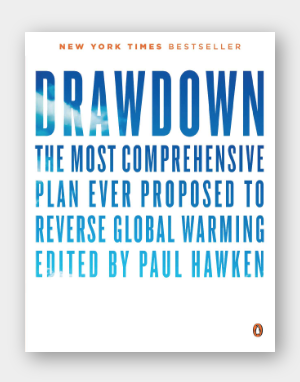
This shift in perspective inspires us to reimagine everything we make and do to the present, creating a wholly different approach and attitude. We take responsibility for what we do and don’t blame others or past happenings. We see extraordinary change in climate as an invitation to build, innovate, and effect change, and take it as an opportunity that awakens creativity, compassion, and genius. As a consequence, in dealing with climate issues, we exercise our humanity.
Many sectors of human activity contribute to global warming including what we eat and how we grow food, the energy we use, what we consume, how we get around and occupy ourselves, places we inhabit, and many other undertakings. Drawdown consolidates 100 solutions into seven major sectors wherein emissions and sequestrations are examined and greenhouse gases investigated for their effect. Rating these strategies, is based on how many giga-tons of CO2, or the equivalent thereof, a solution will remove or keep away from the atmosphere in the years between 2020 and 2050.
The topmost net reduction to global warming, are gases used in refrigeration. Hydrofluorocarbons (HFCs) will start to be reduced actively starting in 2019, but it will take many years before replacement refrigerants are substituted. By replacing global warming refrigerants by 2050, 89.74 giga-tons of CO2 will be reduced from the atmosphere, and a net savings of $902.8 billion will be realized.
Among the 100 strategies researched, nearly one fifth come under the category of energy where solutions involving wind, geothermal, solar farms, and rooftop solar are explained. In one example, an Urnos woman who lives with her two daughters on one of the many islands on Lake Titicaca uses a rooftop panel instead of kerosene to provide electricity for her family. (Fittingly, the Uru People know themselves as Lupihaques, Sons of the Sun.)
Educating girls and family planning rank sixth and seventh among the 100 best ways of reducing global warming. Combined, they will save about 120 giga-tons of warming gases to enter the atmosphere by 2050. Educated girls have fewer, healthier children, have lower maternal mortality, are less likely to see their infant child die, are more familiar with better nourishment and can better contribute to economic growth. In exercising their intrinsic right to education, they also lay a foundation for a substantial sense of self-worth for their families and the community.
At the close of "Drawdown," we are reminded of its beginnings. Reducing global warming depends on cooperation, community, and collaboration. Groups of people; farmers and city dwellers, leaders and acolytes, businesses and non-profits, schools, universities and churches, all participating with nature, are involved. And within each body are individuals who can determine for themselves what best to do. From not dumping the banana skin into the trash to donating to build a school in Kenya, each is collaborating with others and acting as one with nature to further advance us as caring humans.
—Greg Marquez
Drawdown
The Most Comprehensive Plan Ever Proposed to Reverse Global Warming
Edited by Paul Hawken
256 pp. Penguin Books. (2017)



